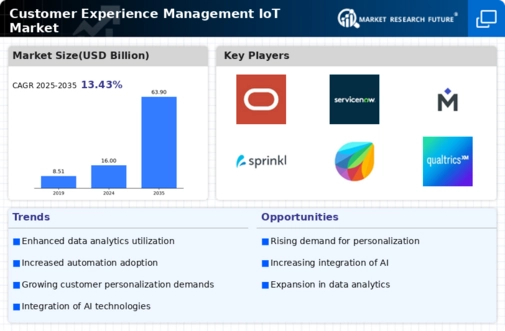Advancements in IoT Technology
Technological advancements in IoT are significantly influencing the Customer Experience Management IoT Market. Innovations such as edge computing and 5G connectivity are enhancing the capabilities of IoT devices, allowing for faster data processing and improved customer interactions. These advancements facilitate seamless communication between devices and systems, enabling businesses to respond to customer needs in real-time. The market for IoT devices is projected to grow substantially, with estimates suggesting a compound annual growth rate of over 25% in the coming years. This growth indicates a robust potential for companies to enhance their customer experience strategies through the adoption of cutting-edge IoT technologies.
Growing Importance of Data Analytics
Data analytics plays a crucial role in the Customer Experience Management IoT Market. The ability to collect, analyze, and interpret vast amounts of data generated by IoT devices enables businesses to gain valuable insights into customer behavior and preferences. This analytical capability allows organizations to make informed decisions that enhance customer experiences. The market for data analytics in IoT is expected to expand significantly, with projections indicating a growth rate of approximately 30% over the next few years. This trend highlights the necessity for companies to invest in robust data analytics tools to remain competitive in the evolving landscape of customer experience management.
Increased Focus on Customer Engagement
The Customer Experience Management IoT Market is experiencing a heightened focus on customer engagement strategies. Businesses are increasingly recognizing the value of engaging customers through various touchpoints, including mobile applications, social media, and IoT-enabled devices. This multi-channel approach allows companies to create cohesive and interactive experiences that resonate with consumers. Research indicates that organizations that effectively engage their customers can achieve a 10 to 15% increase in customer retention rates. As a result, companies are investing in IoT solutions that facilitate real-time communication and feedback, thereby enhancing overall customer engagement and satisfaction.
Shift Towards Proactive Customer Service
The Customer Experience Management IoT Market is witnessing a shift towards proactive customer service models. Businesses are increasingly adopting IoT technologies to anticipate customer needs and address issues before they escalate. This proactive approach not only enhances customer satisfaction but also reduces operational costs associated with reactive service models. Companies utilizing IoT solutions for predictive maintenance and customer support are likely to see improvements in service efficiency and customer loyalty. The trend suggests that organizations that embrace proactive customer service strategies can achieve a competitive edge in the market, ultimately leading to increased customer retention and brand loyalty.
Rising Demand for Personalized Experiences
The Customer Experience Management IoT Market is witnessing a notable increase in demand for personalized customer experiences. As consumers become more discerning, businesses are compelled to leverage IoT technologies to gather and analyze customer data effectively. This data-driven approach enables organizations to tailor their offerings, enhancing customer satisfaction and loyalty. According to recent estimates, companies that prioritize personalized experiences can see a revenue increase of up to 20%. This trend underscores the importance of integrating IoT solutions into customer experience strategies, as they provide real-time insights into customer preferences and behaviors, thereby fostering deeper connections between brands and consumers.


















Leave a Comment